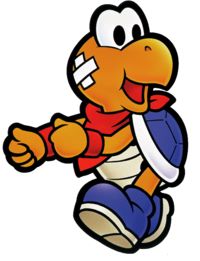Released: August 11, 2000 (JP), February 5, 2001 (USA)
Platform: Nintendo 64
Introduction
Paper Mario is one of Nintendo's first takes on the JRPG (Japanese Role Playing Game) genre. It is considered to be the spiritual successor to Super Mario RPG, which was Nintendo's first JRPG, and includes many twists on the JRPG formula. Like RPGs, there are turn-based battles (Mario attacks, the enemy attacks, Mario attacks, etc...). But button presses can be times to increase the damage Mario deals and reduce the damage he receives, which was one of the many Nintendo-style twists to the genre's formula.
Unlike main series Mario games, Paper Mario has a greater focus on story and characters. The game also has a cartoonish, and sometimes dry, sense of humor. Paper Mario series fans consider this game and the second one to be the best in the series, so this game is usually remembered fondly. And though it was on the 90's-era Nintendo 64, the game has aged well because of its paper artstyle.
Unlike main series Mario games, Paper Mario has a greater focus on story and characters. The game also has a cartoonish, and sometimes dry, sense of humor. Paper Mario series fans consider this game and the second one to be the best in the series, so this game is usually remembered fondly. And though it was on the 90's-era Nintendo 64, the game has aged well because of its paper artstyle.
 |
| CHARM |
Impressions
When I first played Paper Mario in 7th grade, I was immediately in love with the charm of the game. Everything, from the art style, to the battles, resonates such a pure Nintendo charm that few other games can rival. The cast of characters, specifically Mario's battle partners, also stick out to me, as they all have unique designs and often a witty sense of humor.
Gameplay
Overworld
In Paper Mario, the player controls Mario in his adventure through the Mushroom Kingdom. In addition to moving around the 3D areas, Mario can use a hammer and jump a short difference. Along the way, Mario meets 8 characters who act as "partners". One partner follows Mario at a time, and partners can be switched at will. In the world, each partner has an ability that can help Mario, like lighting up a dark area, carrying him over small gaps (picture above), or letting him swim through water.
| Mario uses his partner Sushie to swim |
Battles
In battle, Mario similarly has the option to attack with either with his hammer or by jumping on the enemy. There's a strategy here, because Mario will get hurt if he tries to jump on some enemies (often wearing spikes), and his hammer can't reach flying enemies. In battle, both Mario and his current partner can attack once each turn, and the partners have unique attacks that often are similar to their abilities in the overworld. If there's a flying enemy that is wearing spikes, one of the partners' moves is probably necessary.
| Battling with a partner |
Artstyle
A pretty big part of Paper Mario, and the game's namesake, is its paper artstyle. All of the characters and items in this game are 2D, in a "paper" style, even though the environments and worlds are 3D. When Intelligent Systems made this game they weren't very familiar with making a 3D game, so thats why they went with this style. There are little winks and nods to the paper theme throughout the game, like how when a bridge is built, the screen turns like a page to reveal a bridge behind it. In fact, the game is organized into 'chapters', like a book.
Aside from that, there's really not a lot of gameplay that centers on the idea of paper. It's more of a unique artstyle than anything else.
Characters
While the characters I talked about in Bayonetta 2 and Fire Emblem are like characters from a novel, Paper Mario's characters are more like characters from a storybook, or a fairy tale: they lack much depth, but they seem real. Paper Mario uses these characters to weave a vivid world. I haven't played this game in a few years, but I can remember even the most minor characters because of how unique they are.
The partner characters, as I mentioned before, follow Mario throughout the game once they join his party. Each one is visually distinct and has a different personality. It's hard to explain, but having 8 characters with personalities follow me in game makes it seem like an adventure with friends.
Notes
You may have noticed that I included fewer categories in this post, which is partly because this game isn't noteworthy in all of its aspects, and partly because I'm trying to cut down on the post lengths. Hopefully it will be more readable if its shorter.

No comments:
Post a Comment